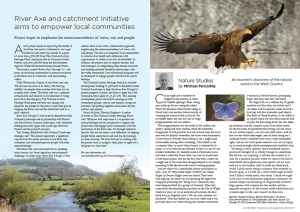
Can an eagle and a butterfly be weighed in the balance, in terms of wildlife sightings? Does seeing one, make up for not seeing the other? That’s the question I find myself asking as I look back over another twelve months of watching the natural world in Dorset. For in wildlife terms the year was one of huge disappointment, but also elation.
The disappointment was the result of the sodden and sunless spring and early summer, when the butterflies disappeared. It will probably turn out to have been the worst year ever for Britain’s butterflies; the losses were horrendous. I wrote here in October about failing to see a single small tortoiseshell; among other vanishings, I also failed to see a common blue, an insect whose beauty is traduced by its name—as if it were the any-old-blue. In fact it is one of our loveliest butterflies; its scientific name is Polyommatus icarus, and were it called the Icarus blue I am sure we would treat it with more respect. But for the first year ever, I didn’t see a single one. It was more than disappointment: it was deeply unsettling. It felt like the world wasn’t working properly.
And yet there was a remarkable nature consolation: in May, a pair of white-tailed eagles overflew our village. Eagles in Dorset! Eagles over our house! They were very high up, but there was no mistaking the eight-foot wingspan producing the “flying door” silhouette; they were being mobbed by a group of buzzards. They had come from the reintroduction project on the Isle of Wight which last year saw (at an undisclosed location) the first chick born in England since 1780; this year another was produced. They had drifted up our river valley and it was probably these two which during the summer established a territory in Poole Harbour, prompting hopes that next year they will breed.
On August 30, on a sublime day of gentle sunshine and blue skies, my wife Jo and I saw them at close quarters, when we took a boat trip with that estimable small charity, The Birds of Poole Harbour. It was billed as an osprey cruise, for that other majestic bird of prey, the fish-eating hawk, has also taken up residence, and this summer a pair successfully nested for the first time and produced four young. On our cruise we saw several ospreys—we saw one catch a fish—and we also saw the white-tailed eagles, one of them sitting on a sandbank barely a hundred yards away, a truly remarkable sight. And we saw both species interact—we saw an osprey try to attack an eagle, which contemptuously swatted it away.
Watching at close quarters these wonderful raptors, previously thought of as wholly foreign to somewhere like Dorset, was inspiring; I still feel the wonder of it. And yet a paradox presents itself: we seem to be able to reintroduce these glamorous rare species, yet we can’t hold on to the familiar stuff. It made me think hard, would I mind never seeing a common blue butterfly in Dorset again, if I could see a white-tailed eagle instead? And I think I would mind, very much. I think we ought to be wary of the charismatic megafauna syndrome: we should temper our favouring of magnetically attractive large species with concern for the smaller and less-regarded occupants of the natural world which have just as much right to life, and a beauty all their own.




